Classification and distribution of soils | Geography Optional for UPSC PDF Download
Soil Classification
Classifying soils in a way that is both useful for geographers and accurately represents the various soil types and variations is quite challenging. There are two primary methods of soil classification used today: one that focuses on the assumed origins of the soil and another that examines the observable properties of the soil profile. The following provides examples of each classification method:- Classification based on the assumed origins of the soil: This method involves categorizing soils according to their formation processes, such as weathering, erosion, and deposition. This helps geographers understand the historical and geological context of a particular soil type.
- Classification based on the observable properties of the soil profile: This method focuses on the physical and chemical characteristics of the soil, such as texture, structure, and color. This approach allows geographers to analyze the current state of the soil and its potential for supporting various land uses and ecosystems.
Both of these methods aim to provide meaningful information about soils for geographers while also accurately representing the wide range of soil types and variations found across the Earth's surface.
Zonal System
The zonal system is a widely-used method for classifying soils, initially proposed by Russian soil scientists (Dukuchaiev and Glinka) who observed a strong connection between climate, vegetation, and soil zones across the globe. This system identifies three primary soil classes.
Firstly, zonal soils are well-developed soils that showcase the significant impact of climate as the primary factor in soil formation. Secondly, intrazonal soils are also well-developed but are formed in areas where a specific local factor is the dominant influence. Lastly, azonal soils refer to those that are either immature or poorly developed.

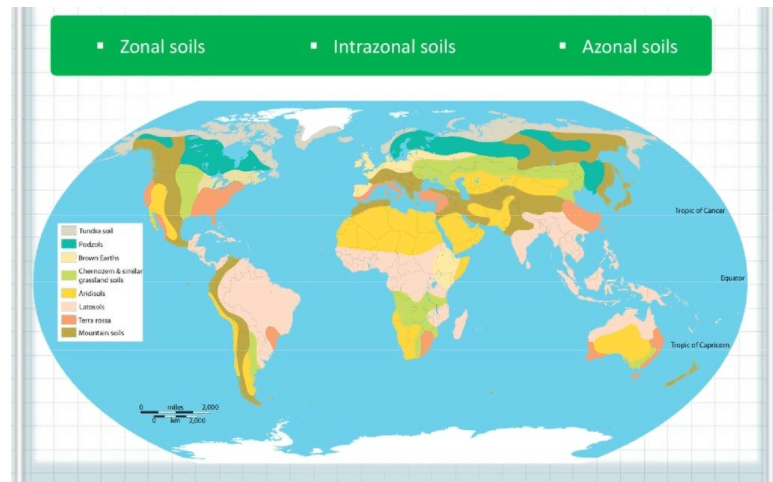
1. Zonal Types
Zonal soils are characterized by their occurrence in broad geographical areas or zones, and are influenced more by the climate and vegetation of the area rather than the rock-type. They are mature soils that have developed under stable conditions over a long period of time. Some examples of zonal soils include:
- Podzols: These soils have a bleached E horizon due to the cheluviation process. They can be found in cool climates south of the tundra region, typically in association with coniferous forests. There are three types of podzols: humus podzol, iron podzol, and gley podzol.
- Brown Earth: These soils occur in milder climates with deciduous forests, equatorward of the main podzol zone. They exhibit less intense leaching than podzols, and their brown color comes from the dispersed distribution of sesquioxides. Brown earths are widespread in Britain, except in highland areas.
- Tundra Soils: These soils have a great variation due to the different patterns of ground ice in the tundra. They can be peaty, thin, or humic, depending on the specific conditions of the area. Examples include brown polar desert soils in Antarctica and Arctic brown forest soils in the northern hemisphere.
- Sierozems: These soils are found in desert and semi-desert areas and can be considered extreme forms of chestnut soils. They have a low organic matter content, but when irrigated, they can be very fertile due to their high base status.
- Chernozem Soils: Associated with steppe or prairie vegetation, these soils have a deep dark layer rich in humus and a calcium-rich horizon deep in the profile. They have a well-developed crumb structure and are most commonly found in areas with loess, such as the mid-west of North America, Russia, and northern China.
- Chestnut Soils: Found in the arid side of the Chernozem belt, these soils have a lower organic content and an illuvial carbonate layer closer to the surface.
- Prairie Soils: These soils occupy the transition zone between chernozems and forest brown earth, with increasing wetness.
- Grumusols: Dark clayey soils found in savanna or grass-covered areas with a warm climate and distinct wet and dry seasons. They are characterized by a high degree of dry-season cracking and are rich in bases, particularly calcium.
- Ferralsols: These soils are found in intertropical areas and are rich in ferric oxide, which gives them their red, brown, or yellow color. They have a low fertility due to their acidic nature and lack of humus and bases.
2. Intrazonal Types
Intrazonal soils are those that develop within other zonal soils, resulting from local factors such as relief, parent material, or age rather than climate and vegetation. There are several types of intrazonal soils, including hydromorphic, calcimorphic, and halomorphic soils.
- Hydromorphic soils are formed in areas with waterlogged conditions, such as marshes, swamps, or poorly drained upland areas. They can be divided into two main categories based on the position of the water table in the soil profile: groundwater gleys, which have ground water below the surface, and surface-water gleys. Gleying is a process that occurs in waterlogged soils where water replaces air in the soil pores, leading to a reduction in oxygen levels and microbial activity.
- Calcimorphic soils are those that develop on calcareous parent material, such as limestone or chalk. Examples of calcimorphic soils include rendzinas, which are dark, organic-rich soils found in association with chalk rock in Britain, and terra rossa, a predominantly mineral soil with a reddish upper horizon rich in clay, commonly found in the Mediterranean region.
Halomorphic (saline) soils are typically found in desert environments and are characterized by high salt content. There are three common types of halomorphic soils:
- Solanchak, also known as white alkali soils, form in depressions and display white salt crusts during dry periods.
- Solonetz, or black alkali soils, are formed through intense alkalinization and are characterized by the presence of sodium carbonate.
- Solodic soils develop when excess sodium in the soil causes the leaching of clays and sesquioxides, resulting in a bleached, eluviated horizon that resembles a podzol.
3. Azonal Soils
- Azonal soils are a type of soil that develops through the deposition process carried out by erosion agents. This means that these soils are formed from fine rock particles that have been transported from distant regions. Azonal soils are often considered immature, as they lack a fully developed soil profile. This could be due to insufficient time for them to develop completely or their location on steep slopes, which hinders profile development.
- There are several reasons why immature soils may exist, including the characteristics of the parent material, the terrain's nature, or simply the lack of time for development. These situations typically arise in areas where fresh parent material is being deposited or exposed.
- Examples of azonal soils include alluvial soils, which have little or no profile development due to their frequent burial under new sediments on active floodplains; Regosols, which consist of dry and loose dune sands or loess; and Lithosols, which are accumulations of imperfectly weathered rock fragments on steep slopes where erosion rates remove soil almost as fast as it is formed.
- There have been several criticisms of the zonal soil concept. One criticism is that a zonal soil type from one climate may be found in another. For instance, podzols, which are typically associated with cool continental climates, can also be found in maritime areas and the tropics. Another issue with the azonal soil classification is that these soils may not necessarily result from a lack of time for development. Instead, they could be due to local factors that have prevented soil development over an extended period. Lastly, soil profiles may not always accurately represent the current climate, as they may have inherited characteristics from previous climates.
USDA Soil Taxonomy
In recent years, the US Department of Agriculture has adopted a system of soil classification based on observed soil properties rather than genetic considerations.
There are twelve (12) orders of soils, which are distinguished largely on the basis of properties that reflect a major course of development, with considerable emphasis on the presence or absence of notable diagnostic horizons.
- Alfisols: “al” for aluminum, “f” for iron (chemical symbol Fe), two prominent elements in these soils
- Andisols: Rock formed from a type of magma in Andes Mountains volcanoes; soils high in volcanic ash
- Aridisols: Dry soils
- Entisols: These are recently formed soils
- Gelisols: Soils in areas of permafrost
- Histosols: These soils contain mostly organic matter
- Inceptisols: Young soils at the beginning of their “life”
- Mollisols: Soft soils
- Oxisols: Soils with large amounts of oxygen-containing compounds
- Spodosols: Ashy soils
- Ultisols: Soils that have had the last of their nutrient bases leached out
- Vertisols: Soils in which material from O and A horizons fall through surface cracks and end up below deeper horizons.
For this analysis, we will group the soil orders based on four factors that can characterize a particular order: maturity, climate, parent material, and high organic matter.
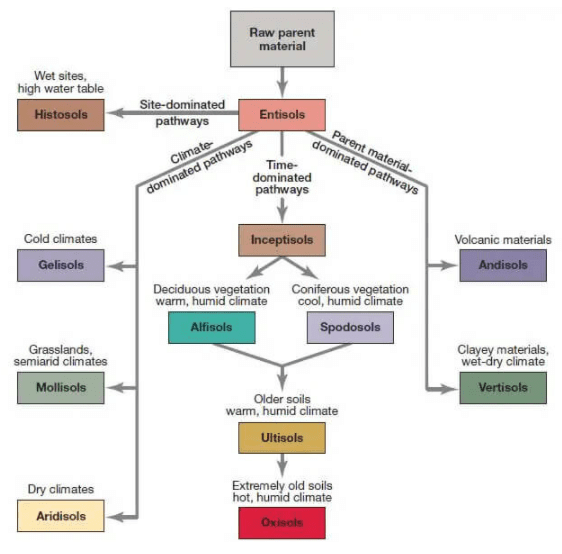
Major orders of the USDA Soil Taxonomy



Soils Characterized By Maturity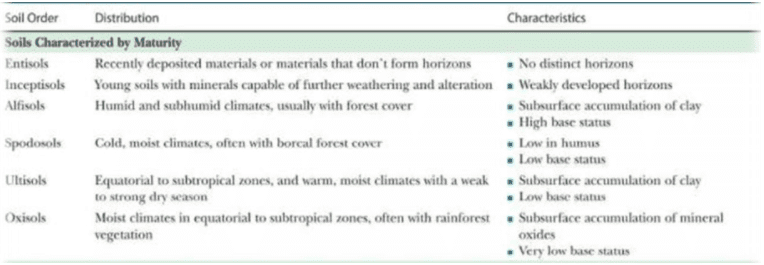
Where materials have been recently deposited soils have no horizons or poorly developed horizons and are capable of further mineral alteration.
Entisols and Inceptisols
- Entisols are a type of mineral soil that do not have distinct layers or horizons. These soils are capable of supporting plant life and can be found in any climate or region. The absence of horizons in Entisols is often due to their recent formation, as they are typically found in newly deposited areas.
- Inceptisols, on the other hand, are soils with only slightly developed horizons, which is usually a result of their young age. These soils can be found in various climates and regions, including river floodplains and deltas. Inceptisols found in such locations are often highly productive, providing fertile ground for plant growth.
Entisols and Inceptisols can be found anywhere from equatorial to arctic latitude zones. Entisols and Inceptisols of floodplains and delta plains in warm and moist climates are among the most highly productive agricultural soils in the world because of their favorable texture, ample nutrient content, and large soil-water storage.
Alfisols and Spodosols
Alfisols are a type of soil characterized by a clay-rich layer created by illuviation (the movement of minerals from one layer to another) and a high base status. They can be found across a wide range of latitudes, from as far north as 60° N in North America and Eurasia to the equatorial regions of South America and Africa. Due to the diverse climate types found in these areas, Alfisols can be further divided into four suborders, each associated with a specific climate:
- Boralfs are found in cold (boreal) forest lands of North America and Eurasia, featuring a gray surface layer and a brownish subsoil.
- Udalfs are brownish Alfisols found in the mid-latitude regions.
- Ustalfs are brownish to reddish Alfisols located in warmer climates.
- Xeralfs are found in Mediterranean climates, characterized by cool, wet winters and dry summers. These Alfisols are typically brownish or reddish in color.
Spodosols, on the other hand, have a light-colored albic horizon (layer of eluviation) and a dense spodic horizon (layer of illuviation). These soils develop under cold needle leaf forests and are generally acidic. They are commonly found in regions that were once covered by the massive ice sheets of the Late Cenozoic Ice Age. In terms of agricultural productivity, Spodosols are considered poor-quality soils. To improve their fertility, the application of lime is necessary to neutralize their acidity.
Oxisols and Ultisols
- Oxisols are soils that form in the humid regions of the equatorial, tropical, and subtropical zones, specifically on land surfaces that have remained stable for extended periods. These soils are commonly found in large areas of South America and Africa, where the climate is wet equatorial and the native vegetation consists of rainforests.
- Ultisols, on the other hand, are similar to Oxisols but have a subsurface layer of clay. These soils develop in environments that closely resemble those where Oxisols are found. Ultisols can be found in various regions, including Southeast Asia, the East Indies, eastern Australia, Central America, South America, and the southeastern United States. Like Oxisols, Ultisols are also susceptible to severe soil erosion, especially on steep slopes.
Soils Characterized By Climate
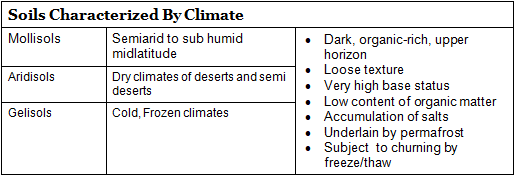
- Mollisols are a type of soil found in grasslands located in sub-humid to semi-arid climates. These soils have a thick, dark brown surface layer called a mollic epipedon. Due to their loose texture and high base status, Mollisols are very fertile and productive. In North America, these soils are prevalent in the Great Plains, the Columbia Plateau, and the northern Great Basin. In South America, Mollisols cover a large area of the Pampa region in Argentina and Uruguay. In Eurasia, these soils are found in a vast belt stretching from Romania to the steppes of Russia, Siberia, and Mongolia.
- Aridisols are desert soils that have weakly developed horizons. They often have subsurface layers containing accumulations of calcium carbonate or soluble salts. These soils can be very fertile if irrigated and managed properly. Aridisols are found in areas with arid climates, such as dry tropical, dry subtropical, and dry mid-latitude regions.
- Gelisols are soils found in permafrost regions where the ground is churned by the freeze and thaw of ice. These soils typically consist of recently deposited parent material left by glacial activity during the Ice Age, as well as organic matter that decays slowly in the cold temperatures.
Soils Characterized By Parent Materials
- Vertisols: These soils develop on specific volcanic rocks in wet-dry climates, particularly under grassland and savanna vegetation. Vertisols expand and contract as they get wet and dry, resulting in deep cracks in the soil. These soils are black in color and have a high content of montmorillonite clay, which is created from the weathering of certain volcanic rocks. The Deccan Plateau in western India is a significant region where Vertisols can be found, as the basaltic rock in this area provides the silicate minerals required to form the necessary clay minerals.
- Andisols: Andisols are distinct soils that form on relatively recent volcanic ash deposits. These soils are dark in color and typically very fertile. They can support dense natural vegetation in moist climates and are found across various latitudes and climate conditions.
Soils Rich in Organic Matter
Histosols: Histosols, also known as peats or mucks, are organic soils that typically form in cool or cold climates where drainage is poor. In the northern regions where Spodosols are common, numerous patches of Histosols can be found. This unique soil category has a high content of organic matter, which is concentrated in a thick, dark upper layer.
General Classification of Soil
Soil classification is primarily based on the specific climate and vegetation in which the soil has formed and developed. Generally, there are two main categories of soils found across the world:- Pedalfurs: These soils are found in humid areas with abundant vegetation. They have a higher content of aluminum and iron but are deficient in essential plant nutrients such as potassium, calcium, and phosphorus.
- Pedocols: These soils develop under arid conditions and retain all the elements necessary for plant growth. They are typically found in regions with less than 25 inches of annual rainfall. Pedocols are generally lighter in color, do not experience leaching, and have an alkaline nature.
These two broad classifications can be further divided into subtypes based on factors such as vegetation type, temperature conditions, and precipitation levels.
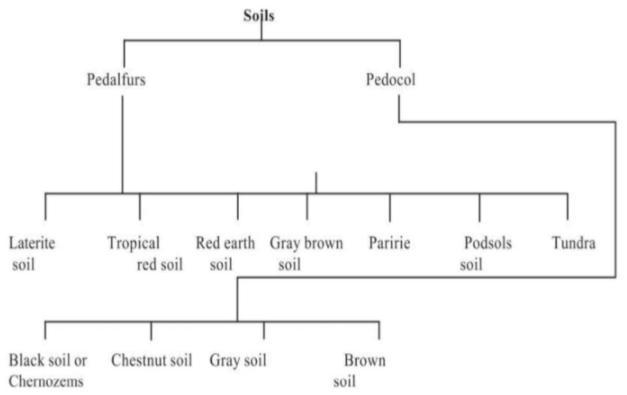
Conclusion
Soil classification is a complex process that aims to accurately represent the diverse range of soil types and variations found across the Earth's surface. Classifications can be based on assumed soil origins, observable properties of the soil profile, or a combination of factors such as climate, vegetation, and parent material. Examples of classification systems include the zonal system, which identifies three primary soil classes, and the USDA Soil Taxonomy, which recognizes twelve major soil orders. Understanding soil classification is crucial for geographers, as it provides valuable information regarding the potential of a soil to support various land uses and ecosystems, as well as insights into the historical and geological context of a particular soil type.Frequently Asked Questions (FAQs) of Classification and distribution of soils
What is the primary difference between classification methods based on soil origin and those based on observable soil properties?
Classification methods based on soil origin focus on the formation processes of the soil, such as weathering, erosion, and deposition, to provide historical and geological context. In contrast, methods based on observable soil properties examine the physical and chemical characteristics of the soil, such as texture, structure, and color, to analyze the current state of the soil and its potential for supporting various land uses and ecosystems.
What are the three primary soil classes in the zonal system?
The three primary soil classes in the zonal system are zonal soils, intrazonal soils, and azonal soils. Zonal soils are well-developed and influenced primarily by climate, while intrazonal soils are also well-developed but are formed in areas where a specific local factor is the dominant influence. Azonal soils are either immature or poorly developed.
What are some examples of zonal, intrazonal, and azonal soils?
Examples of zonal soils include podzols, brown earth, tundra soils, and chernozem soils. Intrazonal soils include hydromorphic, calcimorphic, and halomorphic soils. Azonal soils include alluvial soils, Regosols, and Lithosols.
What is the USDA Soil Taxonomy, and how many soil orders does it include?
The USDA Soil Taxonomy is a system of soil classification adopted by the US Department of Agriculture that is based on observed soil properties rather than genetic considerations. It consists of twelve soil orders, each distinguished by properties that reflect a major course of development and the presence or absence of notable diagnostic horizons.
How does the general classification of soils into Pedalfurs and Pedocols relate to their climate and vegetation?
Pedalfurs are soils found in humid areas with abundant vegetation, resulting in higher aluminum and iron content but deficiency in essential plant nutrients. Pedocols develop under arid conditions in regions with less rainfall, retaining all the elements necessary for plant growth and typically having an alkaline nature.
|
304 videos|717 docs|259 tests
|
FAQs on Classification and distribution of soils - Geography Optional for UPSC
| 1. What is soil classification? |  |
| 2. Why is soil classification important? |  |
| 3. What are the different methods of soil classification? |  |
| 4. How does soil classification help in agriculture? |  |
| 5. What are some common soil types found in different regions? |  |

















